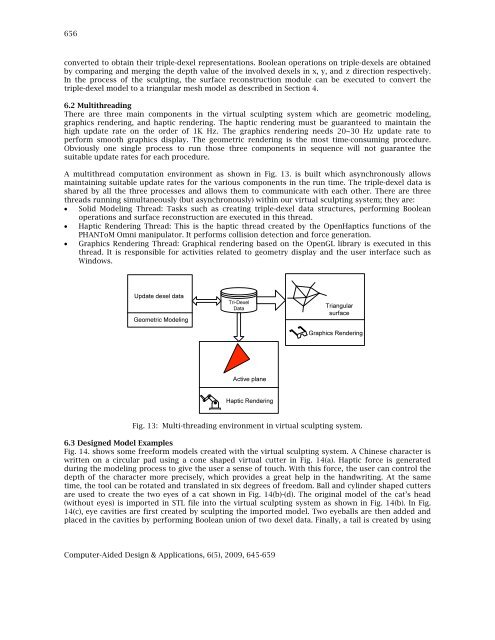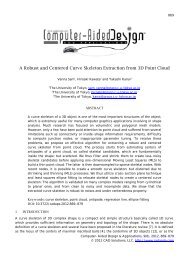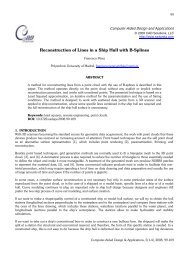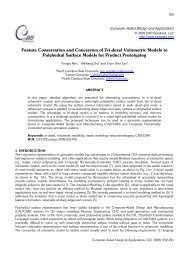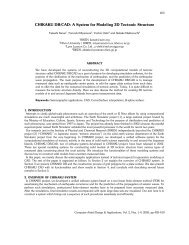A Virtual Sculpting System Based on Triple Dexel Models with Haptics
A Virtual Sculpting System Based on Triple Dexel Models with Haptics
A Virtual Sculpting System Based on Triple Dexel Models with Haptics
Create successful ePaper yourself
Turn your PDF publications into a flip-book with our unique Google optimized e-Paper software.
656<br />
c<strong>on</strong>verted to obtain their triple-dexel representati<strong>on</strong>s. Boolean operati<strong>on</strong>s <strong>on</strong> triple-dexels are obtained<br />
by comparing and merging the depth value of the involved dexels in x, y, and z directi<strong>on</strong> respectively.<br />
In the process of the sculpting, the surface rec<strong>on</strong>structi<strong>on</strong> module can be executed to c<strong>on</strong>vert the<br />
triple-dexel model to a triangular mesh model as described in Secti<strong>on</strong> 4.<br />
6.2 Multithreading<br />
There are three main comp<strong>on</strong>ents in the virtual sculpting system which are geometric modeling,<br />
graphics rendering, and haptic rendering. The haptic rendering must be guaranteed to maintain the<br />
high update rate <strong>on</strong> the order of 1K Hz. The graphics rendering needs 20~30 Hz update rate to<br />
perform smooth graphics display. The geometric rendering is the most time-c<strong>on</strong>suming procedure.<br />
Obviously <strong>on</strong>e single process to run those three comp<strong>on</strong>ents in sequence will not guarantee the<br />
suitable update rates for each procedure.<br />
A multithread computati<strong>on</strong> envir<strong>on</strong>ment as shown in Fig. 13. is built which asynchr<strong>on</strong>ously allows<br />
maintaining suitable update rates for the various comp<strong>on</strong>ents in the run time. The triple-dexel data is<br />
shared by all the three processes and allows them to communicate <strong>with</strong> each other. There are three<br />
threads running simultaneously (but asynchr<strong>on</strong>ously) <strong>with</strong>in our virtual sculpting system; they are:<br />
• Solid Modeling Thread: Tasks such as creating triple-dexel data structures, performing Boolean<br />
operati<strong>on</strong>s and surface rec<strong>on</strong>structi<strong>on</strong> are executed in this thread.<br />
• Haptic Rendering Thread: This is the haptic thread created by the Open<strong>Haptics</strong> functi<strong>on</strong>s of the<br />
PHANToM Omni manipulator. It performs collisi<strong>on</strong> detecti<strong>on</strong> and force generati<strong>on</strong>.<br />
• Graphics Rendering Thread: Graphical rendering based <strong>on</strong> the OpenGL library is executed in this<br />
thread. It is resp<strong>on</strong>sible for activities related to geometry display and the user interface such as<br />
Windows.<br />
Fig. 13: Multi-threading envir<strong>on</strong>ment in virtual sculpting system.<br />
6.3 Designed Model Examples<br />
Fig. 14. shows some freeform models created <strong>with</strong> the virtual sculpting system. A Chinese character is<br />
written <strong>on</strong> a circular pad using a c<strong>on</strong>e shaped virtual cutter in Fig. 14(a). Haptic force is generated<br />
during the modeling process to give the user a sense of touch. With this force, the user can c<strong>on</strong>trol the<br />
depth of the character more precisely, which provides a great help in the handwriting. At the same<br />
time, the tool can be rotated and translated in six degrees of freedom. Ball and cylinder shaped cutters<br />
are used to create the two eyes of a cat shown in Fig. 14(b)-(d). The original model of the cat’s head<br />
(<strong>with</strong>out eyes) is imported in STL file into the virtual sculpting system as shown in Fig. 14(b). In Fig.<br />
14(c), eye cavities are first created by sculpting the imported model. Two eyeballs are then added and<br />
placed in the cavities by performing Boolean uni<strong>on</strong> of two dexel data. Finally, a tail is created by using<br />
Computer-Aided Design & Applicati<strong>on</strong>s, 6(5), 2009, 645-659


